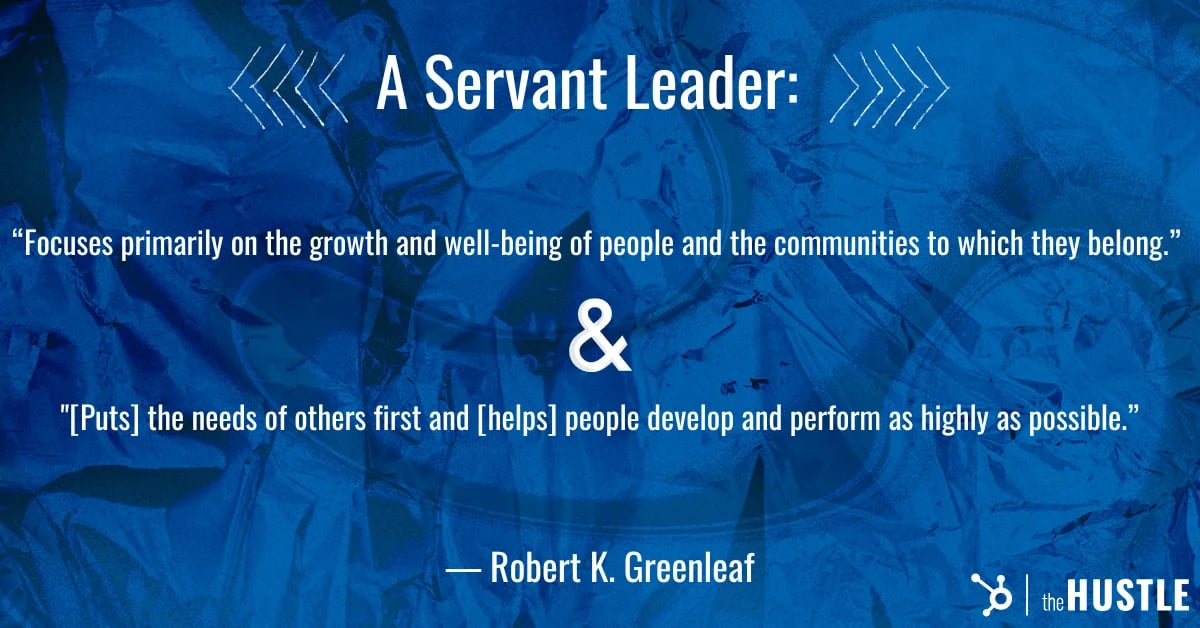The words “servant” and “leader” might seem at odds with each other, but they come together to represent a powerful management style called servant leadership.
Servant leadership centers on empathy, and encourages listening, sharing praise, and helping others grow — all of which can help a company, and its employees, thrive.
What is servant leadership?
Servant leadership is a management style in which a leader acts as a servant to their organization, earning their authority rather than simply imposing control onto others.
In this leadership style, the manager (a boss, CEO, or any type of executive) serves their employees and peers, rather than the other way around. In turn, employees are more motivated and high performing, enabling them to be innovative and successful.
Robert K. Greenleaf first coined the term servant leader in his 1970 essay “The Servant as Leader.” In the essay, he wrote that the servant leader “focuses primarily on the growth and well-being of people and the communities to which they belong.”
These leaders “put the needs of others first and help people develop and perform as highly as possible.”
Servant Leadership Characteristics
In his essay, Greenleaf outlines ten fundamental principles of servant leadership.
1. Listening
Servant leaders must be good listeners to get to know their employees. Knowing your workers on a deeper level allows you to better support their needs and improve their work experience.
2. Empathy
Servant leaders should make employees feel seen, heard, and understood. Empathetic leaders don’t just dole out criticism, but instead work to understand the why behind employees’ actions, allowing them to offer custom solutions and correct behaviors in more positive, productive ways.
3. Healing
Not all employees are used to healthy work environments, and many will take time to become comfortable with the style of servant leadership. Leaders should be patient when getting to know new employees and foster an environment in which they can build trust slowly over time.
4. Self-Awareness
Servant leaders understand their position within their team. For example, if you’re speaking over others in meetings, delivering public criticism, or rigidly enforcing authority, you’re likely not acting as a servant leader, and could be pushing employees away.
Be aware of how you are perceived by your team on a day-to-day basis and alter your actions accordingly.
5. Persuasion
Servant leaders use persuasion instead of power and authority to influence their teams and get everyone on the same page. You should convince others and get buy-in without forcing compliance or telling people that they simply have to do something because you said so.
6. Conceptualization
Conceptualization means that servant leaders can develop a direction for their teams that will bring company success. This requires leaders to think in a conceptual way, looking beyond day-to-day priorities and focusing on the bigger picture.
7. Foresight
Foresight is the ability to predict what will happen in the future. With servant leadership, this means using historical performance and current objectives to predict future outcomes and to estimate what resources employees will need to help them succeed.
8. Stewardship
Stewardship is synonymous with accountability. The leader can take responsibility for their actions and understand how their support for their employees contributes to the overall performance of their teams.
9. Commitment to the Growth of People
Servant leaders want employees to be equipped with the tools and resources they need to succeed. As such, servant leaders must be committed to the growth and development of people.
In practice, this can look like ensuring employees have the proper training for their duties, planning development opportunities, or checking in with workers to understand their career goals and figuring out how to help them get there.
10. Building Community
Workplace communities foster a sense of trust and togetherness, so people feel they are working together to meet a common goal. As a servant leader, ensure your workplace feels like a community by building relationships with others and encouraging people to build relationships with their co-workers.

Servant Leadership Examples
Leading by Example
A servant leader is willing to do any task that they ask an employee to do. If an employee on the social media team is falling behind on the number of posts they need to hit per month, the team manager will step in and take off some pressure by creating posts themselves.
Fostering Collaboration
Servant leaders collaborate with their teams rather than barking orders. This means looping in employees and team members in decision-making processes rather than delivering final outcomes. This way, employees feel invested and engaged in the company, and know their thoughts, feedback, and concerns will be heard.
For example, the director of a marketing department holds a monthly all-hands meeting in which she welcomes feedback from workers. She encourages employees to email her throughout the month with their ideas, and facilitates brainstorming coffee sessions with her team members.
Showing Empathy
Servant leaders show empathy to their employees by making sure everyone on the team knows they are valued as humans and individuals. Empathetic leaders understand where their employees are coming from, and work to make their lives easier, not harder.
For instance, an executive at a tech company wants his employees to know that they bring more to the table than just their hard skills and labor. He implements generous parental leave for those who are starting families, unlimited time-off policies, and programs that cover mental and physical care for employees so that they can take care of themselves well.
Additionally, empathy could be shown by a leader taking the first 10 minutes of every one-on-one meeting to learn more about their employees on a personal level. Upon hearing that one employee has recently suffered a loss in their family, a servant leader would be empathetic to what that might mean for their mental health, and encourage the employee to take personal days.
Being Persuasive
Servant leaders persuade their employees and peers rather than ordering them to follow their lead. Persuasion requires having an effective argument for why you want to make the decision you’ve come to, and is backed with evidence and research.
For example, rather than simply telling the team of writers that their articles need to be half as long, a servant leader would present the data they used to come to that decision. This makes any decision making a more collaborative process.
Building Community
A servant leader will take steps to foster community within their team and the company. This might take the form of scheduling social Zoom events for remote teams, in-person dinners or activities, or team-building retreats and off-sites.
Purposeful programming that makes time for relationship-building outside of day-to-day responsibilities can create deeper relationships between workers.
Listening Well
Though it seems simple, being a good listener separates great servant leaders from the pack. Rather than being checked out in meetings, taking notes or answering emails while their employees speak, good servant leaders listen actively.
This means giving your employees physical cues that you’re hearing them (nodding, smiling, and giving live feedback) as well as following up on the information that’s been presented to you.
This could mean asking follow-up questions, referencing the information in a later conversation, or crediting one of your employees when a different team member mentions their idea.
Although different from leaders following more traditional styles, servant leaders can build motivated and capable teams.
If you’re a leader looking to try your hand at this leadership style, make sure that you understand who your employees are as people, provide them with the tools and support they need to succeed, and act as an ever-present resource.














